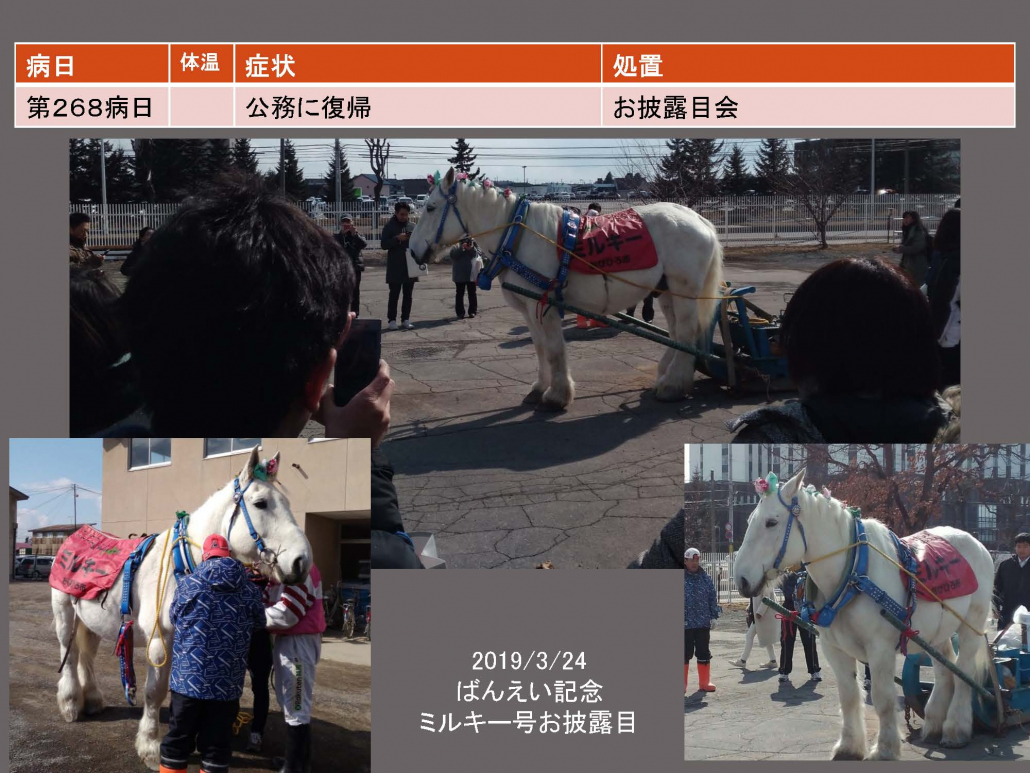A Case of a Heavy Stallion that Recovered from Laminitis-Induced Hindlimb Hoof Detachment

This is a case report of a heavy stallion that recovered from a hoof detachment presented at an academic meeting in Tokachi, Japan.

Horses are affected by a disease called laminitis, which has a poor prognosis. In this case, the patient horse had chronic progressive lymphedema, a disease that is quite specific to heavy horses, and it is characterized by itchy lymphedema of the lower limbs. Horses with this disease are prone to phlegmon with secondary bacterial infection.

In this case, the horse developed phlegmon in the hindlimb from chronic progressive lymphedema, and the affected hindlimb substantially swelled. Subsequently, the horse’s inability to land on the affected leg caused the other leg to develop contralateral limb laminitis. The hoof of the affected animal was detached, i.e., the hoof falls down. Under normal circumstances, no horse survives this condition. However, this is a rare case in which the horse recovered.

This is a picture of the condition.
The limb is quite swollen.

The limb became too painful for the horse to stand; thus, the animal was moved to the stable for treatment, and this is what he looked like at the time. The phlegmon was larger than the hoof and appeared to be painful. The horse also had a fever. At the time, because of this condition, the opposite left hind limb was at risk of developing mechanical overload laminitis; thus, the following treatments were performed:
①Administration of autologous conditioned serum (ACS)
②administration of intravenous regional limb perfusion ozone gel (4000 ppm, 10 mL/30 min)
③ application of ozone to the hoof crown

Despite the intervention, there were signs of definite hoof cracks with discharge from between the skin and nails on day 17 of the illness. The horse was in substantial pain; therefore, the animal was bedridden as shown here. Bedsores were present throughout, and it was widely believed that the stallion would not survive.

Progress from day 126 to 196 of illness

Finally, the horse shed all the hooves that were not needed, and the hooves ended up having a strange shape. However, after hoof trimming, they looked as shown in the picture below, and they regrew from the top. I mentioned earlier that I had performed ozone gel limb perfusion. Additionally, I had been applying ozone gel to the affected areas of the hooves every day for a long time. I believed that the continued application of ozone gel would speed up the process of proper growth of good quality hooves.

Progress on day 268 of illness
I thought it would take a year for the horse’s hoof to recover, but it happened earlier than that, and I was able to show the results.
These are my thoughts after encountering this case.

To summarize, the following aspects highlight this case:
① Early filling with ACS: Minimal hoof bone settlement
② Ozone gel early regional limb perfusion: Reduction in hoof lobe damage due to the effects of antiendotoxin and vasodilation
③ Unilateral laminitis: Partial mechanical overload is possible
④ Affected animals are wise: Easy to treat
⑤ PR horses are affected: An environment where dedicated and continuous treatment is possible .
Controlling laminitis during hot weather was challenging but successful.
First, one of the primary factors that enabled the horse to recover from laminitis was that we could minimize hoof bone subsidence by administering ACS. Second, I thought I had messed things up; however, I could reimperfuse the ozone gel early and administer it when necessary . This reduced damage to the hoof lobe as a result of antiendotoxin and vasodilation. That is how the horse could retain some of his hooves. The laminitis was unilateral, and if all affected areas were suddenly lost, the horse would not be able to stand up. Because partial loading was possible, the slipper-like form was retained, indicating that the intervention was successful.
This is a picture of Milky taken this year. The horse is back as a guide horse for this year’s Banei Kinen. The audience gathered to see Milky, and everyone was happy to take pictures and videos of him. Milky runs back after the event. This is Milky. He returns happily after the event. He passes the horse in front and returns.
“Welcome back, good job!”
Now the horse is doing well, as shown here. It was a perfect recovery.
He was helped with the application of the ozone gel. Thank you very much.

